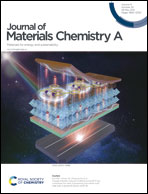RuP2-based hybrids derived from MOFs: highly efficient pH-universal electrocatalysts for the hydrogen evolution reaction†
Abstract
Rational design of efficient, low-cost, and durable electrocatalysts for the hydrogen evolution reaction (HER) in various pH media is highly desirable but remains challenging. Herein, for the first time, we present a novel hybrid of ruthenium diphosphide encapsulated in P-doped porous carbon (denoted as RuP2@PC) utilizing metal–organic frameworks (MOFs) as templates by a multi-step strategy. Unexpectedly, benefitting from the synergistic contribution of highly dispersed ultrafine RuP2 nanoparticles, porous carbon skeleton, and P-dopant, the as-synthesized RuP2@PC exhibits exceptional catalytic activity and superior durability as pH-universal electrocatalysts for the HER. Particularly, a low overpotential of 78.9 mV to deliver a current density of 10 mA cm−2 and a small Tafel slope of 36.7 mV dec−1 can be achieved in 1.0 M KOH toward the HER. Such outstanding electrocatalytic properties exceed those of commercial Pt/C and rank the catalyst among the best HER electrocatalysts reported until now. Importantly, this work paves a new route in elaborately fabricating efficient and stable electrocatalysts based on MOFs for energy-related fields.



 Please wait while we load your content...
Please wait while we load your content...